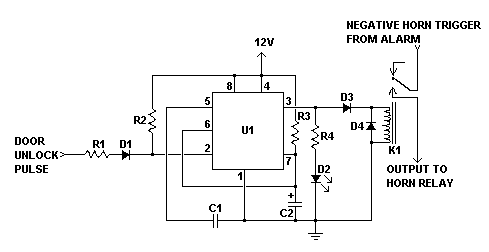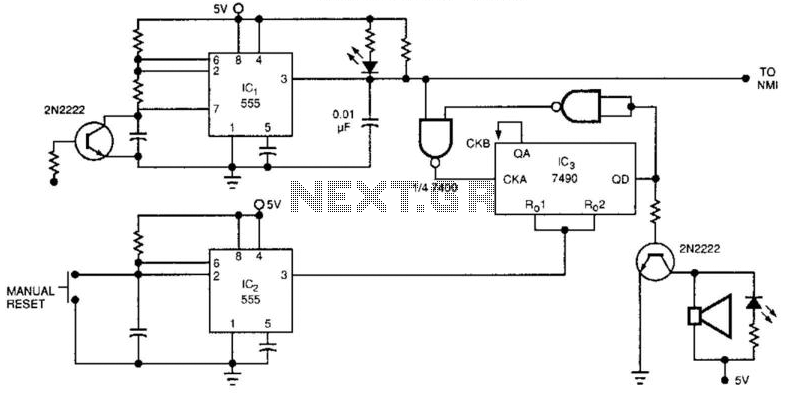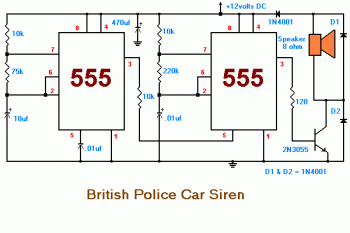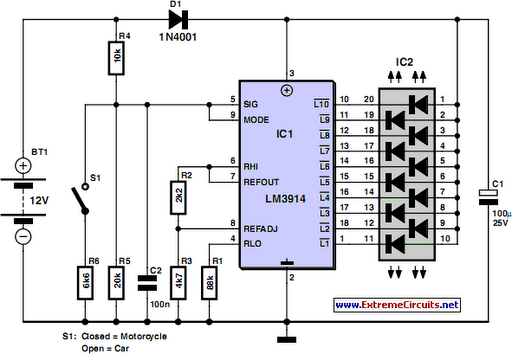
Car Alarm Arming Beep Canceller

It's a great convenience that most modern cars come with a built-in alarm; however, it is nothing but noise pollution that the horn sounds when the alarm is armed. Disconnecting the alarm system from the horn relay will eliminate this but prevent the horn from sounding in the event of an actual alarm. This circuit serves to silence the arming beep yet maintain the alarm by introducing a small delay into the signal. It sits between the alarm and horn relay. The alarm must provide a constant horn signal for at least 3 seconds before the horn relay is activated. That way, the quick "beep" will never activate the horn relay, while the constant alarm signal will.
The circuit described utilizes a 555 timer integrated circuit (U1) configured in monostable mode to achieve the desired delay functionality. The 555 timer is a versatile component that can be used to generate precise timing intervals. In this application, it is triggered by the signal from the alarm system.
When the alarm is armed, it sends a short pulse (the "beep") to the circuit. This pulse is filtered by the resistor-capacitor (RC) network formed by R1 (1KΩ) and C1 (0.01μF), which helps to smooth out the signal and prevent false triggering. The output of the 555 timer will only activate the horn relay (K1) if the input signal remains high for a duration longer than the preset time, which is determined by the values of R2 (10KΩ) and C2 (100μF).
The delay is crucial; it ensures that only a sustained alarm signal, which is longer than 3 seconds, will activate the horn relay. This is achieved by charging the capacitor C2 through the resistor R2, which sets the timing interval. The output from the 555 timer is connected to the relay, which, when energized, will allow the horn to sound for genuine alarm situations.
Diodes D1, D3, and D4 (1N4004) are used for flyback protection to prevent voltage spikes from damaging the circuit when the relay is switched off. D2, the red LED, serves as a visual indicator that the circuit is powered and operational. The resistors R3 (15KΩ) and R4 (470Ω) are used for biasing and current limiting for the LED and other components in the circuit.
The entire assembly is mounted on a PCB, with appropriate connectors and wiring to interface with the vehicle's alarm system and the horn relay. This design offers a practical solution for users who wish to maintain the functionality of their car alarm while minimizing unnecessary noise from the horn during the arming process.It's a great convenience that most modern cars come with a built in alarm, however it is nothing but noise pollution that the horn sounds when the alarm is armed. Disconnecting the alarm system from the horn relay will eliminate this, but prevent the horn from sounding in the even of an actual alarm.
This circuit serves to silence the arming beep yet maintain the alarm by introducing a small delay into the signal. It sits between the alarm and horn relay. The alarm must provide a constant horn signal for at least 3 seconds before the horn relay is activated.
That way the quick "beep" will never activate the horn relay, while the constant alarm signal will. C1 1 0.01uF Ceramic Disc Capacitor C2 1 100uF 35V Electrolytic Capacitor R1 1 1K 1/4W Resistor R2 1 10K 1/4W Resistor R3 1 15K 1/4W Resistor R4 1 470 Ohm 1/4W Resistor D1, D3, D4 3 1N4004 Rectifier Diode D2 1 Red LED U1 1 555 Timer IC K1 1 SPST 12V Automotive Relay MISC 1 Board, Wire, Socket For U1, Case This circuit is by bob and was originally posted to the forum as Need Circuit Project to Improve Remote Car Alarm. 🔗 External reference
The circuit described utilizes a 555 timer integrated circuit (U1) configured in monostable mode to achieve the desired delay functionality. The 555 timer is a versatile component that can be used to generate precise timing intervals. In this application, it is triggered by the signal from the alarm system.
When the alarm is armed, it sends a short pulse (the "beep") to the circuit. This pulse is filtered by the resistor-capacitor (RC) network formed by R1 (1KΩ) and C1 (0.01μF), which helps to smooth out the signal and prevent false triggering. The output of the 555 timer will only activate the horn relay (K1) if the input signal remains high for a duration longer than the preset time, which is determined by the values of R2 (10KΩ) and C2 (100μF).
The delay is crucial; it ensures that only a sustained alarm signal, which is longer than 3 seconds, will activate the horn relay. This is achieved by charging the capacitor C2 through the resistor R2, which sets the timing interval. The output from the 555 timer is connected to the relay, which, when energized, will allow the horn to sound for genuine alarm situations.
Diodes D1, D3, and D4 (1N4004) are used for flyback protection to prevent voltage spikes from damaging the circuit when the relay is switched off. D2, the red LED, serves as a visual indicator that the circuit is powered and operational. The resistors R3 (15KΩ) and R4 (470Ω) are used for biasing and current limiting for the LED and other components in the circuit.
The entire assembly is mounted on a PCB, with appropriate connectors and wiring to interface with the vehicle's alarm system and the horn relay. This design offers a practical solution for users who wish to maintain the functionality of their car alarm while minimizing unnecessary noise from the horn during the arming process.It's a great convenience that most modern cars come with a built in alarm, however it is nothing but noise pollution that the horn sounds when the alarm is armed. Disconnecting the alarm system from the horn relay will eliminate this, but prevent the horn from sounding in the even of an actual alarm.
This circuit serves to silence the arming beep yet maintain the alarm by introducing a small delay into the signal. It sits between the alarm and horn relay. The alarm must provide a constant horn signal for at least 3 seconds before the horn relay is activated.
That way the quick "beep" will never activate the horn relay, while the constant alarm signal will. C1 1 0.01uF Ceramic Disc Capacitor C2 1 100uF 35V Electrolytic Capacitor R1 1 1K 1/4W Resistor R2 1 10K 1/4W Resistor R3 1 15K 1/4W Resistor R4 1 470 Ohm 1/4W Resistor D1, D3, D4 3 1N4004 Rectifier Diode D2 1 Red LED U1 1 555 Timer IC K1 1 SPST 12V Automotive Relay MISC 1 Board, Wire, Socket For U1, Case This circuit is by bob and was originally posted to the forum as Need Circuit Project to Improve Remote Car Alarm. 🔗 External reference





